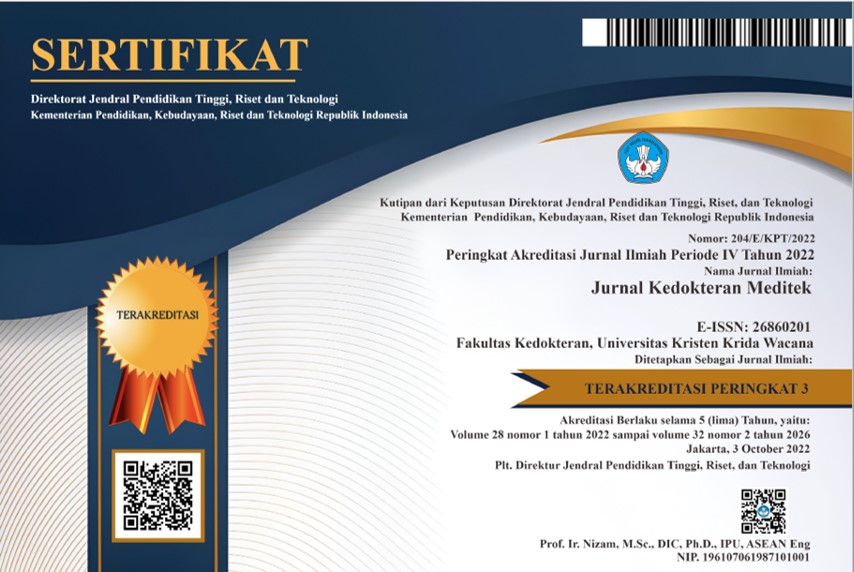Efektivitas Latihan Otot Dasar Panggul dalam Mencegah Konstipasi Pasien Stroke Non Hemoragik
DOI:
https://doi.org/10.36452/jkdoktmeditek.v27i1.1924Keywords:
konstipasi, latihan otot dasar panggul, strokeAbstract
Konstipasi banyak ditemukan pada pasien stroke non hemoragik. Konstipasi ini disebabkan oleh gangguan hubungan antara sistem saraf dan pencernaan akibat penyumbatan pembuluh darah otak oleh trombus atau embolus. Bahayanya adalah saat mengejan akibat konstipasi, terjadi peningkatan tekanan intra kranial, sehingga penting dilakukan pencegahan konstipasi. Tujuan penelitian ini adalah untuk menilai efektivitas latihan otot dasar panggul dalam mencegah konstipasi pada stroke non hemoragik. Penelitian ini menggunakan desain quasy experiment terhadap 66 subjek yang dipilih dengan teknik purposive sampling, masing-masing 33 subjek pada kelompok intervensi dan kelompok kontrol. Latihan otot dasar panggul dilakukan 3 kali sehari selama 3 hari dan dievaluasi pada hari ke-4, konstipasi diukur menggunakan Bristol Stool Chart. Berdasarkan uji statistic Chi-square, didapatkan bahwa ada perbedaan kejadian mencegah konstipasi subjek stroke non hemoragik, antar kelompok kontrol dan intervensi (p<0,05). Kesimpulannya adalah latihan otot dasar panggul efektif mencegah konstipasi pada subjek dengan stroke non hemoragik. Peneliti merekomendasikan pasien stroke non hemoragik untuk melakukan latihan otot dasar panggul secara rutin dengan bantuan keluarga.
References
2. Kim B, Lee J, Sohn MK, Kim DY. Risk factors and functional impact of medical complications in stroke. Ann Rehabil Med [Internet]. 2017;41(5):753–60. [cited 9 Nov 2019] Available from: https://www.ncbi.nlm.nih.gov/pmc/articles/PMC5698661
3. Lin C, Hung J, Cho C, Tseng C, Chen H, Lin F, et al. Post stroke constipation in the rehabilitation ward : incidence, clinical course, and associated factors. Pubmed. 2013;54(11):624–9.
4. Lin K, Granger CL, Denehy L, Frawley HC. Pelvic floor muscle training for bowel dysfunction following colorectal cancer surgery : a systematic review. 2015;712:703–12.
5. Li J, Yuan M, Liu Y, Zhao Y, Wang J, Guo W. Incidence of constipation in stroke patients. Medicine (Baltimore). 2016;(October):1–6.
6. Iffgd. About constipation. Int Found Gastrointest Disord [Internet]. 2019; [cited 23 Oct 2019] Available from: https://www.iffgd.org/advocate-for-digestive-health
7. Kemenkes. Germas diet seimbang. [Internet]. 2018; [cited 23 Oct 2019] Available from: http://p2ptm.kemkes.go.id/infographic-p2ptm
8. Guyton A. Fisiologi manusia dan mekanisme penyakit. edisi 3. Jakarta: EGC; 2012.
9. The International Urogynecological Association (IUGA). Constipation [Internet]. Burnsville; 2017. [cited 02 Dec 2019] Available from: https://www.yourpelvicfloor.org/conditions
10. LeMone P, Burke MK, Bauldoff G. Keperawatan medikal bedah gangguan neurologi. Jakarta : EGC; 2017.
11. Smeltzer SC, Bare BG, Hinkle JL, Cheever KH. Brunner & Suddarth’s textbook of medical-surgical nursing. Edisi 12. Philadelphia: Lippincott Williams & Wilkins; 2010.
12. Baert AL, Knauth M. Imaging pelvic floor disorders. In: Stoker J, Taylor SA, Delancey JOL, editors. Medical radiology diagnostic imaging. Heidelberg: Springer; 2010.
13. Clinicians from physical therapy and rehabilitation at center BIDMC. Constipation and the pelvic floor muscles. Esth Isr Deaconess Med Cent. 2016;1–4. [cited 19 Oct 2019] Available from: https://www.bidmc.org/centers-and-departments
14. Farahman, Abedi, Dooki, Jalilian, Tabari. Pelvic floor muscle exercise for paediatric functional constipation. 2015;9(6):16–7. Journal of Clinical and Diagnostic Research [cited 28 Sep 2019] Available from: https://www.ncbi.nlm.nih.gov/pmc/articles/PMC4525569
15. LeMone P, Burke MK, Bauldoff G. Keperawatan medikal bedah: gangguan gastrointestinal. Edisi 5. Iskandar MT, editor. Jakarta: EGC; 2016.
16. Alligood MR. Pakar teori keperawatan. Singapura: Elsvier; 2017.
17. Relief application. Sample size calculator. Relief Application; 2018. [cited 23 Nov 2019] Available from: https://www.calculator.net/sample-size-calculator.html
18. Kemenkes. Germas faktor risiko stroke. [Internet].2018 [cited 27 Dec 2019] Available from: http://p2ptm.kemkes.go.id/artikel-sehat/germas-cegah-stroke
19. Boehme KA, Esenwa C, Elkind MSV. Stroke risk factors, genetics, and prevention. Stroke Compend. 2017 [cited 29 Oct 2019] Available from: https://www.ncbi.nlm.nih.gov/pmc/articles/PMC5321635
20. KemenKes RI. Infodatin stroke. Jakarta:Kemenkes; 2019. [cited 04 Dec 2019] Available from: https://pusdatin.kemkes.go.id/article/view/20031000003/infodatin-stroke.html
21. Potter PA, Perry AG. Fundamental of nursing [Internet]. Edisi 4. America: Elsevier; 2017. [cited 19 Sep 2019] Available from: https://books.google.co.id/books
22. Ford C, Lacy BE, Talley NJ. Irritable bowel syndrome. New engl J Med. 2019;2566–78.
23. Pribakti. Dasar-dasar uroginekologi. Jakarta: Sagung Seto; 2011.
24. Baessler K, Schussler B, Burgio KL, Moore H, Norton PA, Stantion SL. Pelvic floor re-education. Edisi 2. London: Springer- Verlag; 2012.
25. Kolcaba K. Comfort line [Internet]. 2019. [cited 20 Jan 2020] Available from: https://www.thecomfortline.com/
Downloads
Published
How to Cite
Issue
Section
License
Copyright (c) 2021 Veroneka Yosefpa Windahandayani

This work is licensed under a Creative Commons Attribution-NonCommercial-ShareAlike 4.0 International License.


















